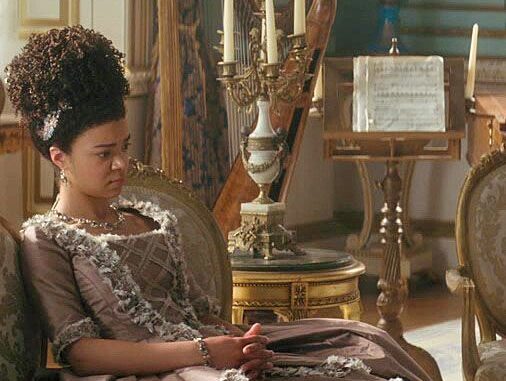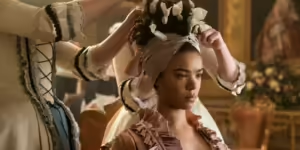
Queen Charlotte wasn’t always the confident and powerful leader you see in ‘Bridgerton.’
The long-awaited Bridgerton Season 3 has finally released its first four episodes on Netflix, once again riling us up for the steamy and dramatic world of Regency London. With Queen Charlotte (Golda Rosheuvel) taking her time with choosing a diamond this season, it is hard not to be reminded of her spin-off series that delves into the past and present of three powerful women in the original show. With a dual timeline and three major storylines, Queen Charlotte: A Bridgerton Story delicately explores issues of marriage, mental health, and grief and how they were handled in 18th-century England. Both period pieces are loosely inspired by the real monarchy of the time but also deal with social constraints on both women and men in the upper class. Dressed in extravagant fabrics and clad with poise, the prequel influences the way we perceive characters and relationships in Bridgerton and provides a backstory for the characters’ decisions and motivations. And, of course, we see the origins of Queen Charlotte’s outrageous wigs.
How ‘Queen Charlotte’ Fits With ‘Bridgerton’s Timeline
Operating on two distinctly different timelines, Queen Charlotte clearly connects past decisions and events to the present. The black opening scene with typewritten white letters and the sultry voice of Lady Whistledown (Julie Andrews) fades in, setting up the historical roots of the fictional story and making it acutely clear to us that the events of this series take place before Bridgerton. We are first introduced to the younger version of Queen Charlotte in Germany with the perfect casting choice of India Amarteifio, a British actress who masterfully plays the sassy but scared role of Charlotte. It begins with 17-year-old Charlotte receiving the news of her wedding to Prince George III of England (Corey Mylchreest), a wedding that took place in September 1761 in real life. Assuming the show based the timeline on the historical events that inspired it, the wedding in the show would have been at a similar time. The rest of this storyline covers around one and a half years, as Charlotte is confined in Buckingham Palace for her long faux honeymoon and gives birth to an heir.

The “present-day” timeline is unclear at first, but it is confirmed in Episode 2 and 5 that they are in the months at the end of Bridgerton Season 2 but preceding the epilogue that directly takes us to Season 3. During the Queen’s tea with Lady Violet Bridgerton (Ruth Gemmel) and Lady Agatha Danbury (Adjoa Andoh), the Queen asks Violet how she managed to arrange two of her children’s marriages in two years. We saw her eldest daughter’s wedding in the first season of Bridgerton and her eldest son’s love story in the second, indicating the events took place after the vibrant social season of that year. This is also reflected in the more dull and dreary ambiance of this timeline, rich with cool tones in lieu of the pastel ones in the original.
But it is during Violet and Agatha’s conversation at the art exhibition in the sixth episode that confirms that Anthony (Johnathan Bailey) is on his honeymoon. The second season of Bridgerton concludes with Anthony and Kate (Simone Ashley) returning from their six-month honeymoon, enjoying a summery day at the Bridgerton’s ancestral home. As such, the events of the series must occur between the chaos of the Featherington Ball and the feel-good epilogue. So if you were vying to re-watch the franchise in somewhat of a chronological order, begin with the first two seasons of Bridgerton, then Queen Charlotte, and return to the evolving Season 3.
How the Events of ‘Queen Charlotte’ Influence ‘Bridgerton’
As the title suggests, the Netflix series centers around the origins of Queen Charlotte, particularly her tumultuous marriage and how she gradually shouldered and accepted her role as the queen. So, naturally, the series mainly expands on how we interpret the Queen’s actions and obsessions in Bridgerton. We witness how she is bartered in order to tidy up alliances between Germany and the British Empire: thrust into a marriage with a stranger and into a crown attached with responsibilities she is yet to comprehend. As she discovers her husband’s mental health issues and their hindrance in his ability to rule, she learns to take up the reins and fulfill the duties of a queen. In Bridgerton, Queen Charlotte is the face of the monarchy. Her husband’s deterioration forces him behind closed doors and the Prince Regent is rarely mentioned. Queen Charlotte demonstrates how Charlotte became such a dominant force; it was through trials and tribulations that caused her to grip her power so tightly, afraid that any slight mistake may cause her husband’s precariously holding on the crown.
